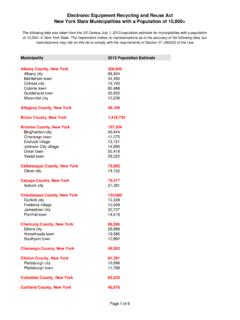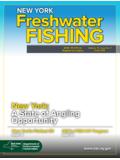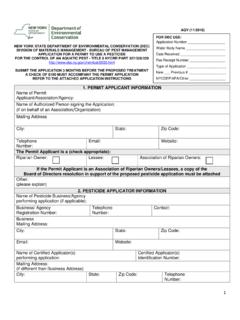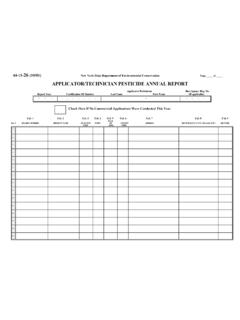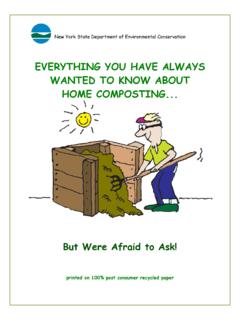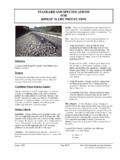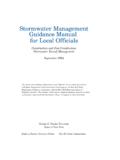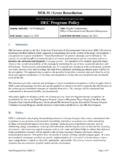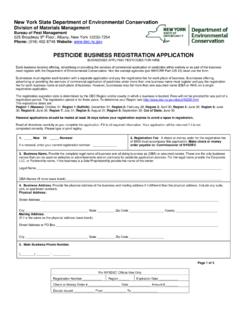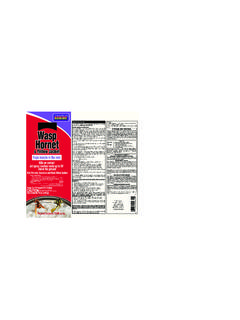Transcription of Managing and Disposing of Household Hazardous Waste
1 New York State Department of Environmental Conservation Division of Materials Management Bureau of Waste Reduction and Recycling Printed on 100% post-consumer recycled paper Topics in this Publication Facts on Household Hazardous Waste General Information Acids and Bases aerosol Containers Antifreeze and Brake Fluids Automotive Batteries Electronics and Household Batteries Household Cleaners and Personal Products Medicines Mercury Motor Oil and Automobile Products Paint Thinners, Strippers and other Solvents Wood Preservatives Pesticides Miscellaneous Chemicals For Further Information Facts on Household Hazardous Waste We like to think of our homes as our castles.
2 But most of us are not thinking of what's stashed in the basement, garage or under the kitchen sink. Take a look sometime. Do you see old cans of cleansers, paint, bug spray and used motor oil? How long has it been since you used this stuff? How will you get rid of it? Those types of Waste contain Hazardous substances which can pose risks to the environment, wildlife and human health. Hazardous substances have one or more special characteristics which include: The potential to cause violent chemical reaction. The potential to be dangerously corrosive. The potential to ignite. The potential to be harmful to human health (toxic).
3 Every year in New York State, more than 100,000 tons of these Household Hazardous wastes are emptied into trash cans. They end up in landfills or incinerators, or may be dumped onto backyard soil or into small streams. Household Hazardous wastes enter the environment from lawns, backyards, sewers, landfills and incinerators. When disposed improperly, those wastes can poison the air, soil, water, birds, fish, mammals and even people and pets in the following ways: Once in the landfill, liquid Waste and rainwater can seep down through layers of trash picking up contam-inants along the way. This will cause leachate to be more difficult and expensive to treat.
4 Streams and lakes, as well as groundwater, can become polluted where rain, melting snow and ice contact contaminated soil, sidewalks, streets and parking lots. Storm sewers drain directly into local waterways. Emissions from incinerators can contaminate air and the ash residues, which contain heavy metals, also present disposal problems. As residents of New York State, we bear the responsibility to dispose of our Household Hazardous Waste properly in order to protect and preserve the quality of our groundwater, streams and lakes. In the following pages, you will find instructions on how to SAFELY dispose of most of the Household Waste chemicals you may have at home right now.
5 You will also learn how to REDUCE your use of these products by buying or making alternatives so you'll have less to throw out in the future. Follow these steps and you will be making your home, your neighborhood and all of New York State a cleaner, greener place to live. It's easy and it's good for the earth! General Information Waste REDUCTION Use non- Hazardous alternative products and materials when possible. Only buy as much as you need when purchasing Hazardous substances. If you can't use it up, give it to someone who can. Schools and community groups may be especially grateful for donations of paint.
6 SAFE STORAGE Keep the product in its original container. Never mix different chemical products. Wrap the Waste in newspaper and place in two layers of plastic garbage bags. Label the outside of the bag. Store in an out-of the-way location, away from heat and children or pets. Ignitable wastes should be stored away from the house if possible. It is always best to avoid Disposing of Hazardous Household products, Try to buy only what you need. Look for less toxic alternatives. Recycle when possible. Give unused products to someone else who can use them (unless the product is a pesticide which has been banned or restricted).
7 If you are left with a product which is unusable, banned, not recyclable, or which cannot be given away, look on the label for disposal information. Be aware, however, that older containers of pesticides and other wastes may give instructions which are no longer appropriate. In cases such as these, or if the label gives insufficient information, you may need to store the Waste until a Household Hazardous Waste collection program is held in your area. Certain Household Hazardous wastes identified in the following pages can be safely dried out or solidified. Cat litter (clay type with no chemical additives), disposable diapers, vermiculite and other products specifically designed for use with chemicals do not react with chemical wastes and may be safely used as absorbents.
8 Air drying should always be done in a well-ventilated area away from children and animals. Explosive wastes usually cannot be handled through Household Hazardous Waste collection programs. Explosives include not only ammunition, but certain chemicals, such as picric acid, ether, and concentrated hydrogen peroxide ( Household strength is not explosive). If you have any of these wastes, contact your local police department for further information. This information is provided only for individuals who need to dispose of wastes derived from their residential use. Disposal of wastes which are the result of any commercial or industrial activity MUST comply with applicable Hazardous Waste regulations.
9 Acids and Bases Both acids and bases are corrosive materials and may cause damage upon contact with the skin, eyes or respiratory system. They may also react violently if mixed with other substances, including water. Acids are corrosive materials commonly found in toilet bowl and drain cleaners, swimming pool chemicals and a number of other home cleaning products. These are easily identifiable on ingredient labels because they usually contain the word "acid." Bases are also corrosive, and may be found in bleaches, oven and drain cleaners, disinfectants and other Household products. They may be listed on labels as lye, hydroxide, hypochlorite or a variety of other terms.
10 ALTERNATIVES Keep drains clean by using strainers and keeping grease, hair and coffee grounds out of the drain. Flush drains weekly with boiling water or a cup of warm vinegar. Use a plunger or snake to free blockage. To clean the oven, sprinkle baking soda or salt on spills with water and scrub with a steel wool pad. Scrub toilets with baking soda or borax. To polish metal, rub with a paste of baking soda and water; polish unlacquered brass, bronze or copper with a solution of equal parts of vinegar, flour and salt. Rinse and dry. DISPOSAL If the acid or base is an ingredient in a useable consumer product, try to use it up or give it to someone else who can use it.
